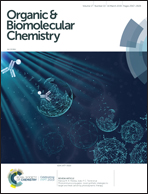The bio-based methyl coumalate involved Morita–Baylis–Hillman reaction†
Abstract
We report the first use of renewable, bio-based, non-hazardous feedstock methyl coumalate (MC) in organocatalyzed Morita–Baylis–Hillman (MBH) reactions. This atom-economical pathway employs inexpensive Et3N as a catalyst in ethanol. Synthon MC efficiently constructs C–C bonds with various imines and aldehydes in moderate to good yields. This catalytic process is triggered via an unprecedented 1,6-conjugated addition, as opposed to the classical MBH reaction. Moreover, this methodology expands Morita–Baylis–Hillman donor capabilities to a 2-pyrone derivative for the first time. MBH adducts described herein could be applied to the synthesis of fine chemicals with biologically active structural cores, such as diphenylmethanol, hydroisobenzofurans, and hydroisoindoles.



 Please wait while we load your content...
Please wait while we load your content...